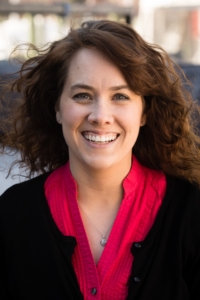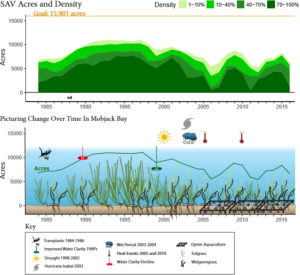CRC’s Environmental Management Career Development Program works with the Chesapeake Bay Program partnership to offer three-year staff opportunities for science, management, and policy graduates as the partnership works to protect and restore the Chesapeake Bay. As part of their time in the program, CRC Staffers are encouraged to explore their career interests and take on projects that allow them to grow their skill sets. We are pleased to report that five CRC staffers will be presenting at the upcoming Restore America’s Estuaries 9th National Summit on Coastal and Estuarine Restoration and Management and at the American Geophysical Unions Fall Meeting. If you are planning to attend either event, be sure take the opportunity to learn about their work.
RAE 9th National Summit on Costal and Estuarine Restoration and Management
- Laurel Abowd – Implementing Adaptive Management: Lessons Learned from the Chesapeake Bay Program Partnership (Poster)
- Margot Cumming and Paige Hobaugh – Monitoring SAV Recovery in the Chesapeake Bay (Poster)
- Michelle Williams – Tracking Local PCB TMDLs to Promote Interjurisdictional Collaboration in the Chesapeake (Poster)
AGU Fall Meeting
- Cuiyin Wu – The Chesapeake Bay TMDL 2017 Midpoint Assessment (Poster)
There are currently thirteen CRC Environmental Management Staffers supporting Chesapeake Bay Program initiatives for various lengths of time as each position follows its own timeline. The blended rotation of Staffers through the program affords new Staffers the opportunity to learn from the experiences of senior Staffers as they begin to navigate their way through the complexities of Chesapeake Bay restoration. We had the opportunity to sit down with Melissa Merritt, one of our senior Staffers who supports the Bay Program’s Scientific, Technical Assessment, and Reporting (STAR) Team, and take a look back at her time with us while she prepares to exit the program and tackle the next step in her career with a health IT company.
 CRC: Welcome, Melissa! Thank you for sitting down with us and reflecting on your time in the program. For those who might not be familiar, tell us about your role with STAR.
CRC: Welcome, Melissa! Thank you for sitting down with us and reflecting on your time in the program. For those who might not be familiar, tell us about your role with STAR.
Melissa: STAR is one of the more technical teams within the Chesapeake Bay Program partnership and I help STAR in providing and coordinating monitoring-related science needs. I staff six workgroups that focus on everything from maintaining data quality to show progress, to the impacts of climate change on that progress in the future. Beyond providing support for these workgroups, I’ve found my niche in helping communicate among our team members, as well as other goal teams of the Chesapeake Bay Program.
CRC: As you look back on your nearly three years in the program, of which accomplishments are you most proud?
Melissa: I’m proud of figuring out a much broader definition of what communication looks like. I’ve tapped in to a few projects during my time here that I feel help connect the dots of Chesapeake Bay restoration in various ways. One project that helped expand my communication skills was thanks to Dr. Jeni Keisman, coordinator of one of STAR’s workgroups, who gave me a role in developing factsheets explaining trends of submerged aquatic vegetation for the past thirty years. I was able to work with experts in the field to develop the best way to show this data, as well as communicate it to a wider audience.

One of the graphics created by Melissa Merritt for the 57 fact sheets to describe submerged aquatic vegetation conditions in the Chespeake Bay. With help from partners VIMS, UMCES, and CBP Communications experts.
Another project I’ve enjoyed working on, is coordinating a forum for the CRC staffers to help align our professional development activities with Chesapeake Bay Program needs. We hold meetings where we share current projects, talk about what skills we want to develop, and help each other find activities within the Chesapeake Bay Program partnership office that would help us grow while providing value to the Bay Program’s goals.

Results from a 2017 survey Melissa Merritt developed for the CRC Staffers in which they identified skills they would like to develop at the Bay Program.
During my time here, I’ve also been involved in HerChesapeake, created by a previous staffer, Lauren Taneyhill, which is network of women who support each other and work for a healthier Chesapeake Bay. This group is run by communications experts, so I’ve learned a lot about how to engage people as their membership and recruitment coordinator.
CRC: During your time with us, you have focused most of your professional development activities on science communications. What drew you to that particular topic?
Melissa: My staffer position puts me right in the middle of data collection and analysis. There’s data everywhere! But I’ve also realized that it takes a lot of work to talk about that data in a way that makes sense to people. I’ve learned that the best way to convey information is in a visual form or with a story. During my time as a staffer, I took classes on how best to show data with programs like Excel, Tableau, and GIS, and also communication elements with design principles and writing. I think clear communication takes a lot of learning and practice.
CRC: As your time in the Career Development Program starts winding down, what do you hope to do next with all you’ve learned and accomplished at the Bay Program?
Melissa: The Bay Program has helped me learn how to coordinate and organize multiple groups toward a common goal. I’ve come to appreciate the process required to bring people together and hash out next steps. I plan to continue using my coordination and communication strengths developed at the Bay Program in future work.
CRC: If you could pass along one piece of advice to a new Staffer, what would it be?
Melissa: If there’s something that you have an interest in and maybe a project you’d like to do, talk to someone about it! From my experience, a staffer’s skills here are always welcomed. And there’s no limit to the ways in which you can use those skills. As a staffer, I’ve asked to talk to experts on everything from how to process samples in a lab, to web user experience and content creation. Sometimes asking people for a half-hour coffee chat to learn about their work is the best way to hear about what might interest you AND gain a great support network. It’s how I’ve done much of the work I’m most proud of here (and it’s helped in job interviews!).
CRC: Thank you for your time, Melissa. It has been great hearing about your experiences in the program and getting a chance to share some of your great work!
For additional information regarding CRC’s Environmental Management Career Development Program, please contact Melissa Fagan, Environmental Management Career Development Program Coordinator at faganm@chesapeake.org. Funding for CRC’s Environmental Management Career Development Program is provided through a cooperative agreement with the US EPA.
